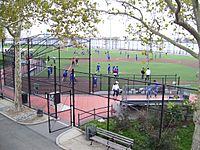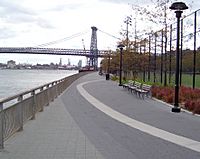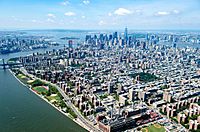East River Park facts for kids
Quick facts for kids East River Park |
|
|---|---|
| Location | Manhattan, New York |
| Etymology | named after John V. Lindsay |
| Status | Partially Open / Under Construction |

East River Park, also known as John V. Lindsay East River Park, is a large public park in Manhattan. It covers about 57.5 acres (23.3 hectares) and is managed by the New York City Department of Parks and Recreation. The park stretches along the East River from Montgomery Street to 12th Street, running alongside the FDR Drive. The Williamsburg Bridge goes right over the middle of the park.
East River Park has many fun things to do. It used to have an amphitheater for shows, which was rebuilt after 9/11. The park also has fields for football, baseball, and soccer. You can find courts for tennis, basketball, and handball. There's a running track and bike paths, including the East River Greenway. Many people enjoy fishing along the East River shoreline.
In 2012, Hurricane Sandy caused a lot of flooding in the park and nearby areas. This led city officials to plan a big project to protect the area from future floods. The idea was to raise the park's ground level. This way, the park itself could act like a protective wall against storm surges and flooding. In December 2019, the New York City Council approved a large project called the East Side Coastal Resiliency project. This project involved completely rebuilding the park. The work began in 2021 and is expected to finish in 2026.
Contents
Discovering East River Park's Past
How the Park Began
East River Park first opened on July 27, 1939. It was an idea from Robert Moses, a famous city planner. Before the park was built, this area along the East River was a busy shipping yard. Later, it became home to many of the city's poorest immigrants.
The park quickly became the biggest green space on the Lower East Side. Over the years, some parts of the park were changed for road projects, like making the FDR Drive wider. Even with these changes, the park has always been a peaceful place for local residents. It's especially nice in the summer when cool breezes come from the river.
Caring for the Park
In 1998, the Lower East Side Ecology Center started helping to take care of the park. This local group worked to keep the park beautiful. Their offices were in the Fire Boat House, near the Williamsburg Bridge. Every year, thousands of volunteers helped the Ecology Center. They tended to garden beds and planted many native plants and flowers.
After the September 11, 2001 attacks, the city rebuilt the park's amphitheater. It had become old and needed repairs. A new soccer field was also built at this time. Companies across the U.S. donated materials for the rebuilding. The project finished very quickly and was dedicated to children who lost parents in the attacks. In December 2001, East River Park was renamed after former New York City Mayor John Lindsay.
In 2008, the City Parks Foundation started offering free music, dance, and theater shows at the amphitheater. This helped bring more people from the community to the park. The first show was a music concert that drew 1,500 people. Other famous artists also performed, attracting crowds of over 3,000.
Protecting the Park from Floods
Plans for a Stronger Park
When Hurricane Sandy hit in 2012, East River Park and the Lower East Side were badly flooded. This made city officials think about ways to prevent future floods. In 2013, the U.S. Department of Housing and Urban Development (HUD) started a competition called Rebuild by Design. Experts were asked to create solutions for areas hit hard by Hurricane Sandy.
One big idea was called the "Big U." This plan suggested building a protective wall around Lower Manhattan. A major part of the Big U was the East Side Coastal Resiliency project. This project aimed to make the park and the surrounding neighborhood much safer from floods. The first plan, supported by locals, was to build an 8-foot (2.4 m) protective wall along the FDR Drive. This would help reduce flooding. From 2015 to 2018, city agencies worked with the community on this design.
Changing the Plan
In early 2018, the city reviewed the plan. They found some challenges, like concerns about flooding and the location of power lines. In September 2018, the Mayor's office announced a new plan. Instead of a wall, the entire park would be raised much higher. Officials said this new plan would be faster and cause less disruption to residents. It would also be more effective and cheaper.
The new plan needed approval from local community boards and the New York City Council. In July 2019, the city presented the new plan to Community Board 3. The City Council usually supports decisions made by local council members for their areas. Council members Margaret Chin and Carlina Rivera worked to get changes to the plan. The original idea was to close the park completely from 2020 to 2023. But after protests from residents, the plan was changed in late 2019 to a partial closure over five years. In December 2019, the City Council approved the $1.45 billion East Side Coastal Resiliency project. This project involves completely rebuilding the park and raising it by 8 to 10 feet (2.4 to 3.0 m). A 2.4-mile (3.9 km) barrier would be built under the park.
Rebuilding the Park
The demolition work started in December 2021. This led to protests and court challenges against the project. In early 2022, construction began on the southern part of the park. This included tearing down athletic fields, the amphitheater, and part of the East River Esplanade. The work is expected to continue until 2026, and large sections of the park will be closed during this time.
In August 2022, asbestos was found under the amphitheater. This raised concerns among activists. The city announced that the asbestos had been safely removed by October 2022.
By September 2024, the city government had finished rebuilding two of the park's ballfields. A new footbridge at Delancey Street also opened. This was part of the first stage of the East Side Coastal Resiliency project. The second stage, which includes rebuilding the rest of East River Park, is set to be completed in 2026. In May 2025, a section of the rebuilt East River Park south of the Williamsburg Bridge was reopened for public use.
Concerns About the Project
Some people have concerns about the current renovation plan. They worry about the high cost, how the project is managed, and that residents weren't involved enough in the final decisions. They are also upset about the destruction of plants, including over 1,000 mature trees, and animal homes. Some critics suggested building storm barriers along the FDR instead. Community members also argue that closing the park mostly affects low-income residents and that the project might actually leave the area more open to storm surges during construction.
However, supporters of the plan include Councilwoman Rivera, other politicians, and local groups like Good Old Lower East Side (GOLES).
In February 2020, several groups and individuals, including members of East River Park Action, sued the city to stop the project. They argued that the plan would separate the park from the community and needed state approval. In August 2020, a judge ruled against these groups, allowing the city to start the demolition. Some local politicians also supported the protesters.
Images for kids
-
The promenade along the East River opened in 2010; the Williamsburg Bridge is in the background.
See also
 In Spanish: East River Park para niños
In Spanish: East River Park para niños





